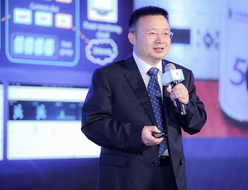The Power Grid Industry Is Diving Deep into 5G Commercialization
August 5, 2019

At Huawei’s 5G is ON summit held during MWC Shanghai 2019 on June 25, Hong Danke, Chief of Communications Division of Power Dispatching and Control Center, China Southern Power Grid (CSG), gave a speech on South China Power Grid’s research on 5G + smart grid application. During his speech, Mr. Hong discussed China’s current energy revolution where smart grids are bringing the industry to a safer, more reliable, and more eco-friendly future.
During his presentation, Mr. Hong said that with this energy revolution being seen across China, the transformation of traditional electrical grids into smart grids has become an inevitable trend. He said, we are moving from centralized power generation to distributed renewable generation. The focus of power grid companies is shifting from safe power supply to supply reliability, and the electricity industry has been undergoing a process of market-oriented reform. Therefore, smart grids, which are safe, reliable, and green, are a new trend.

Hong Danke, Chief of Communications Division of Power Dispatching and Control Center, China Southern Power Grid
Diving deep into 5G commercialization
Communications has become one of the main bottlenecks for smart grid development. In China, there are a large number of electricity utilities scattering across the country, but most of these facilities and equipment are not monitored or controlled remotely. This issue needs to be urgently addressed in order to measure and control the performance of electricity utilities and equipment. Electrical communications are becoming an important part of smart grid control. Particular issues to be addressed in that aspect are information transmission security, high-quality transmission, variance adaptation, and management and control of communications resources.
Mr. Hong went on to explain the fundamentals of smart grids and how they will enable all kinds of physical objects, including transformers and towers, to be measurable and detectable. This process is also set to locate and eliminate faults as soon as they occur, ensuring safe operations and reliable supply. 5G technology has become a critical part of these automated, smart, and interactive power grids.
“The three main application scenarios of 5G and network slicing will better meet the requirements of smart grids in terms of safety, reliability, and flexibility,” Mr. Hong said. “They will also help build virtual private networks for power grids and achieve high-level security isolation based on actual needs. Currently, CSG has over 4 million 3G and 4G cards. 5G will better satisfy the needs of our smart grid development.”
CSG also announced at this event that it has made a smart grid development plan, covering all stages of grid production. With the progress of building smart grids, CSG’s demand for high bandwidth, low latency, and massive connectivity from production to consumption will become increasingly more urgent. The power grid industry has become one of the first industries that is thoroughly exploring 5G commercialization.
Setting 5G application benchmarks in the electricity sector
CSG has attached great importance to the development of 5G. The company believes that the requirements of smart grids can only be addressed by identifying their needs and integrating these needs into 5G standards.
CSG is at the forefront in this regard. In 2018, it partnered with Huawei to submit several proposals and key applications to various standards bodies. CSG later went on to develop a 5G-enabled smart grid roadmap and build a 5G testing platform in the real-world environment with other industry partners. They have used this platform to test power grid services such as protection of distribution network, and made some achievements.
In his presentation, Mr. Hong was very optimistic about network slicing, as CSG had already carried out end-to-end field tests on network slicing. Network slicing is a main feature of 5G, but whether it can be used in power grids depends on whether it can meet the security requirements. According to the tests conducted by CSG and Huawei, the security of information and management services can be guaranteed by isolating that from public services during grid production and control. These tests prove that network slicing can ensure hard isolation and the quality of power grid services.
Mr. Hong later said that as 5G commercialization continues, CSG will continue working with partners to explore more service scenarios and scale up pilot tests to verify the application of various power grid services in typical scenarios and 5G’s capacity in these scenarios. In doing so, CSG aims to build their own technical standards system, set a benchmark for 5G applications in vertical industries, and speed up the application of 5G-enabled smart grids.
Proactively resolving management and business model issues
“We have been resolving various technical problems in applying 5G to the power grid since 2017, but there are some issues in terms of our management and business models that need to be solved,” said Mr. Hong.
The first issue Mr. Hong described related to how power grid companies coordinate with carriers when building smart grids. Power grid companies want full 5G coverage in remote areas, but if carriers have different business scope, construction progress, and guidelines from power grid companies, it will adversely affect the construction of smart power grids.
The second issue related to slicing management, specifically how power grid companies manage and control the entire power supply process. Power grids are a necessity to every household and are part of critical national infrastructure. That means any problems that occur in power grid control must be resolved promptly.
The final issue Mr. Hong noted was on cost. With the large-scale application of smart grids, renewable resources such as wind and solar power are becoming more widely used. Increasing numbers of people are also driving electric vehicles, increasing the demand for charging stations and inline power meters. With over 90 million power meters and trillions of various intelligent sensors and terminals already in place, CSG is faced with various challenges in terms of ensuring all power devices are being detected and measured accurately. However, the traffic tariff approach currently used by CSG fails to fully address this issue. Mr. Hong stated that this problem must be addressed by changing business models, and that if it is not handled properly, it may become a serious obstacle to industry development.
There are always more solutions than problems. Mr. Hong concluded his speech by saying that 5G will find extensive applications in the future, and he hoped that everyone will work together to drive the development of 5G.
Read more about:
Vendor SpotlightsAbout the Author(s)
You May Also Like












_1.jpg?width=300&auto=webp&quality=80&disable=upscale)


.png?width=800&auto=webp&quality=80&disable=upscale)